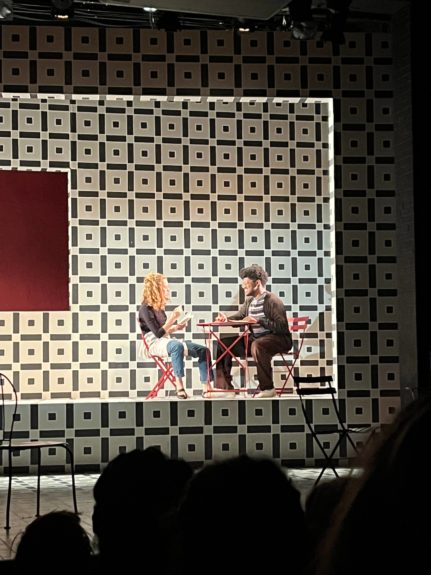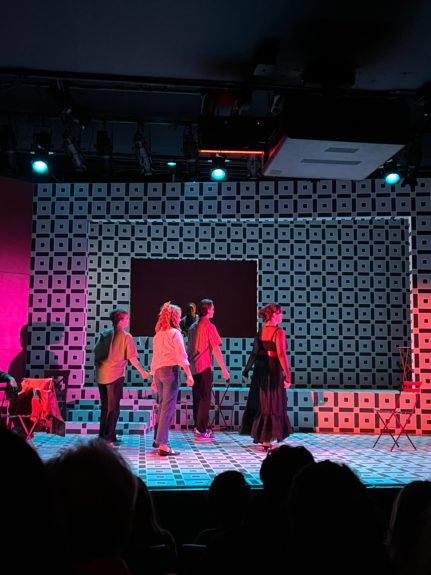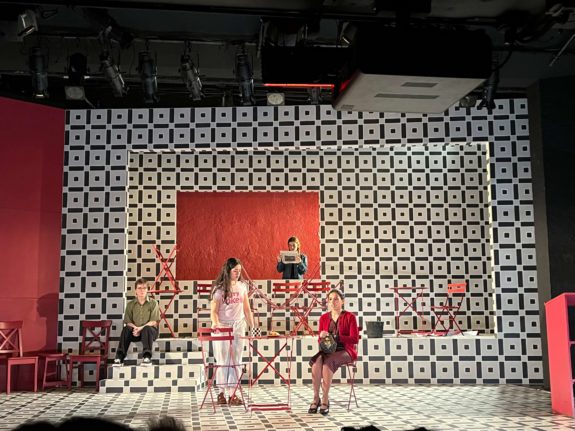On Saturday afternoon, Staff Writer Olivia Chiroiu and Deputy Arts Editor Isa RingswaldEgan attended Barnard Theatre’s production of Inspired by French Cinema, devised and directed by Javier Antonio Gonzalez.
Amidst war and political conflict we often seek out some form of escape, whether through substances, stories, or simple romanticization. Most central to Inspired by French Cinema is escape through the latter. Romanticization of one’s life comes in many different colors and forms, but for close friends Leo, played by Jalen Ford (CC ‘24), and Julie, played by Amelia Mason (BC ‘24), French cinema is the inspiration for how they frame their lives. Inspired by French Cinema takes a nuanced look at living an artistic life in a politically charged setting, creating an incredibly prescient piece.

Set in the Upper West Side of 2003, the playful, meta-reflective, and at times mildly sardonic play follows the two friends and playwrights struggling through grad school at Columbia as they meet the cast of an upcoming independent play. The two become wrapped up in its production and cast, especially the dramatic and alluring star Celine, played by Eleanor Babwin (BC ‘24). Enamored with Celine’s charisma and lifestyle, Julie and Leo enter into a whirlwind romance with her before a tumultuous end coinciding with the final performance of the play. The context of the ongoing Iraq war and upcoming GOP convention becomes increasingly more relevant and complicates the artistic and personal lives of the characters.
The Minor Latham Playhouse was transformed to reflect the title, with a black and white tiled sprawled across the stage and walls, accented by red set pieces and backwalls. The visual connotations of Jian Jung’s scenic design aligned with the playbill’s own description of its set, which was “inspired by movie theater lobbies” and used “imagery easily associated with Parisian love and coffee shops.” The staging also set up multiple planes of action, with characters traipsing from one level to another in ways that matched the dynamic and fragmentary nature of the play. Through the audience’s imagination and the movement of bright red chairs, the set morphed from a cafe to a play rehearsal to a subway car, all while maintaining its fanciful and striking visual aspect.
Leo and Julie’s friendship, Leo’s romantic relationship with Cyd Marie, Ibadah Adam (BC ‘24), Julie and Leo’s relationship with Celine, playwright Arthur’s, Aden Karp (CC ‘25), struggles to let his art and relationships go, director Francine’s, Jordan Danielle Baptiste (BC ‘25), fight to make art mean something, and choreographer Brigitte’s, Caroline Adams (BC ‘25) later relationship with Julie and the imprint Celine left behind all cohere to create incredibly complex and well-formed character arcs. These sober moments were contrasted by sudden dance sequences backed by songs like “Ça Plane Pour Moi” by Plastic Bertand, and “Gasolina” by Daddy Yankee, reminding the audience that the performers didn’t take themselves too seriously.

The production boasted an excellent cast, presenting endearing and distinct characters that we grew to understand and invest in. Within the ensemble, Nicholas Meyers (CC ‘24) shone in all of the roles he played, from a cranky old man to a witty and irreverent member of the motley theater troupe, through his physicality and naturally hilarious line deliveries. As Jean, Claire Ponnaiya (CC ‘24) portrayed a member of the theater crew with a distinct point of view on the social climate and the intentions of their play, and his frustrations and commentary felt honest and nuanced. Throughout the play, the cast’s banter and synergy made their bond and development tangible and authentic.
The central performances were also outstanding. Even before I knew that Celine would be a key character and the object of Julie and Leo’s transfixations, I myself was captivated by Eleanor Babwin’s stage presence. She commanded with every line, larger than life but also lived-in and enigmatic. As Julie, Amelia Mason was quick, cerebral, and deeply likable, guiding us through every beat and shift of the story. Likewise, Jalen Ford fully embodied Leo, charmingly playing off of every character, especially his intellectual match Julie.

While the play oscillated between naturalistic scenes and stylized moments of whimsy and drama, everything seemed to develop the play’s themes of the power and limitations of art. Whether characters were engaging in serious discourse about the point of the play they were making, or the show was calling attention to itself as an art piece through dance sequences and surrealistic lighting, I was made to reflect on the very nature of theater and under what circumstances it can not only reflect, but affect society. These meditations came to the forefront towards the end, when scenes surrounding political outrage, tragedy, and the melancholy passage of time became more abstract but still carried an immense amount of weight. By the end, I began to fully appreciate every complex loose end of the play and the myriad sources it drew from––after all, how can artists take on the burden of making meaning out of life and war when those things lack reason themselves?
Images via Authors


 0 Comments
0 Comments